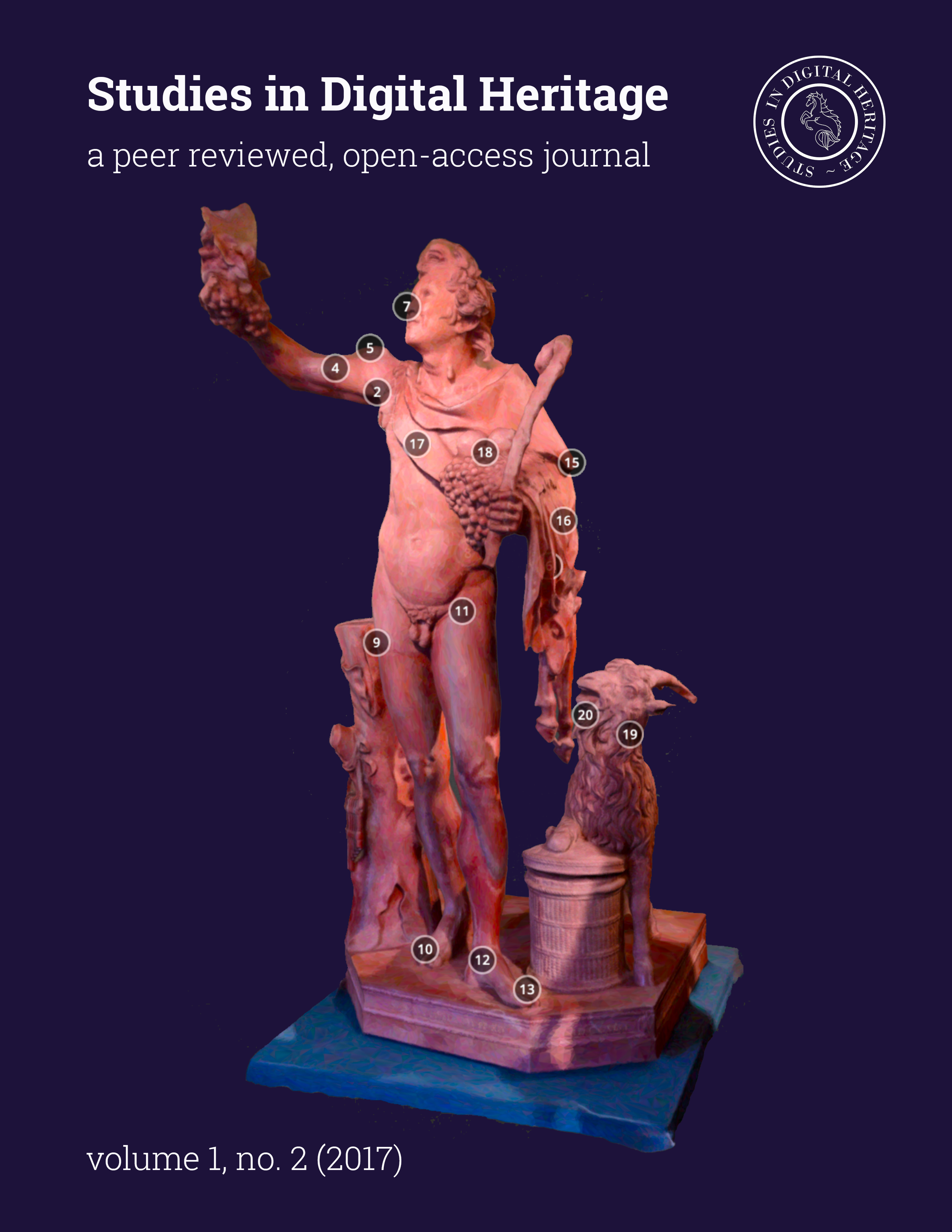Apps under the surface. Problems with Cultural Heritage apps
Main Article Content
Abstract
Apps for mobile devices are being made with the goal of telling the story of cultural heritage to general public. If they actually reach the target audience or if the apps are being used often, is not clear. This is particularly of relevance in the Netherlands as most apps are partially or completely financed with public money and being made for municipalities or other local government-organisations.
The authors noticed and encountered several things concerning cultural heritage apps. The apps are often anything but good or perfect in function and presentation. When looked at the download-data, it becomes also clear that many apps are not very often downloaded and installed.
When researching why this is the case several observations were made. From the local government-side there seems to be a lack of understanding of what could or should be achieved. This happens because goals are not being set, target audiences aren’t being thoroughly researched, etcetera. Sometimes the main goal was simply to build or have an app that displays and tells the story of a Cultural Heritage site. Often a company or department gets a set of parameters and simply builds an app around it. Furthermore the promotion of apps is relatively spares after the initial presentation. Often it becomes just a small message on the appropriate website and nothing else.
Not everything mentioned above can be remedied, but a better understanding of which goals an app should have and what can be achieved combined with better promotion can lead to better apps and a better use of them by the general public. That leads back to a better return on the (often) public spending for making the app, not to mention of raising the awareness of the specific Cultural Heritage presented.
Downloads
Article Details
From 18 May 2018, the contents of Studies in Digital Heritage are licensed under a Creative Commons Attribution-NonCommercial 4.0 International License (CC BY-NC 4.0). Our submitting authors pay no fee and retain the copyright to their own work.
How this works: to submit their work to the journal, authors grant Studies in Digital Heritage a nonexclusive license to distribute the work according to a CC BY-NC 4.0 license. Once an article is published, anyone is free to share and adapt its contents—provided only that they do so for noncommercial purposes and properly attribute the shared or adapted information. Details of these terms can be found on the Creative Commons website.
Download SDH’s full author agreement here
Studies in Digital Heritage will insert the following note at the end of any work published in the journal:
© [Year] by the authors. This article is an open-access article distributed under the terms and conditions of the Creative Commons Attribution License CC BY-NC 4.0 (https://creativecommons.org/licenses/by-nc/4.0/).
References
Anne Frank Huis /Anne Frank Museum. 2017. Bezoekcijfers museum (2017) retrieved January 25 2017 from : http://www.annefrank.org/nl/Nieuws/Pers/Bezoekcijfers/
Barrett G., 2016. Pokémon Go is doing just fine, with or without you (2016). retrieved November 1 2016 from : https://www.wired.com/2016/09/pokemon-go-just-fine-without/
BBC. 2016. Why Pokemon Go may have passed its peak (2016) retrieved January 16. 2017 from http://www.bbc.com/news/technology-37176782
Bunt, A. van de, 2011, Nieuwe Media & Archeologie (rapportage stage-opdracht bij TGV Teksten en Presentatie). Leiden.
Nadja Debenjak and Kaisa Mäki-Petäjä, in: CHNT20, 2016, Revealing hidden histories with modern technology – Archaeological Information Systems and geolocalisation. Vienna.
Giulia Dionisio and Anna Margherita Jasink, in: CHNT20, 2016, Teaching new technological methodologies applied to ancient history. Vienna.
Eiman Elgewely, Egypt and Willeke Wendrich, in: CHNT20, 2016, Reviving Karanis (Egypt): From Mud Bricks to Urban and Social Fabric. Vienna.
Samanta Greggio and Giuseppe Salemi, in: CHNT20, 2016, A mobile Augmented Reality system integrating 3D model and radiance scaling to enhance epigraphical inscriptions. Vienna.
Adele Magnelli and Matteo Ventrella, in: CHNT20, 2016, How the AR can help to appreciate the hidden value of pictorial masterpiece: Venice’s Gallerie dell’Accademia case history. Vienna.
Elisabeth Monamy, in: CHNT20, 2016, Experience archaeology or bringing archaeology to a wider public. Vienna.
Colleen Morgan, Robert Carter, Michal Michalski, in: CHNT20, 2016, The Origins of Doha Project – Online Digital Heritage Remediation and Public Outreach in a Vanishing Pearling Town in the Arabian Gulf . Vienna.
Matthias Pacher, in: CHNT20, 2016, The museum of prehistory MAMUZ as a cultural touristic impulse for a rural area in Lower Austria. Vienna.
Paget, M. 2016: Pokemon Go Loses More Than 15 Million Daily Users in a Month. Pokemon Go engagement and interest in augmented reality has also dropped. (2016) retrieved august 8, 2016 from: http://www.gamespot.com/articles/pokemon-go-loses-more-than-15-million-daily-users/1100-6442938/
Het Parool. 2016. Rijksmuseum ontvangt meer dan twee miljoen bezoekers in 2015 (2016). retrieved January 29, 2017 from http://www.parool.nl/kunst-en-media/rijksmuseum-ontvangt-meer-dantwee-miljoen-bezoekers-in-2015~a4207435/
Davide Pantile and Valerio Rossi, in: CHNT20, 2016, Magna Carta Rediscovered: enhancing tourism through a travelling multimedia exhibition. Vienna.
Nevena Radojevic, in: CHNT20, 2016, Looking the Pazzi Chapel’s umbrella vault from its oculus. Vienna.
Rijksmuseum. 2016. Weer een topjaar voor Rijksmuseum (2016), retrieved January 16, 2017 from https://www.rijksmuseum.nl/nl/nu-in-het-museum/nieuws/weer-topjaar-voor-rijksmuseum
Jochen Schmid, in: CHNT20, 2016, The palace facade of Tell Halaf as part of the reconception of the Museum of the Ancient Near East – Material monumentality or virtual multiplicity. Vienna.
Smith, G. 2017 75+ Incredible Pokemon Go Statistics. (2017) retrieved January 17, 2017 from http://expandedramblings.com/index.php/pokemon-go-statistics/
Claudiu Silvestru, in: CHNT20, 2016, Experiencing Medieval Vienna – New Approaches towards the Presentation and Interpretation of Invisible Cultural Heritage. Vienna.
Morten Valdorff Rasmussen, in: CHNT20, 2016, On-site communication, old bones and new audiences. Vienna.
Various. 2017 Noordbrabantsmuseum. Boschjaar-2016 (2016) retrieved November 1 2016 from http://www.hetnoordbrabantsmuseum.nl/bezoek/tentoonstellingenactiviteiten/tentoonstellingen/boschjaar-2016/


